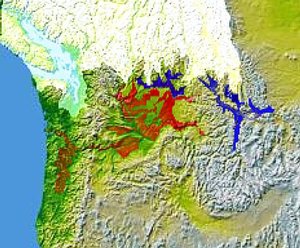Missoula Floods
|
|
The Missoula Floods refer to the catastrophic floods that swept periodically across eastern Washington and down the Columbia River Gorge at the end of the last ice age.
The floods were the result of the periodic sudden rupture of the ice dam on the Clark Fork River that created Glacial Lake Missoula. After each rupture of the ice dam, the waters of the lake would rush down the Clark Fork and the Columbia River, inundating much of eastern Washington and the Willamette Valley in western Oregon. After the rupture, the ice would reform, recreating Glacial Lake Missoula once again.
Geologists estimate that the cycle of flooding and reformation of the lake lasted on average of 55 years and that the floods occurred approximately 40 times over the 2,000 year period between 15,000 and 13,000 years ago.
The Missoula Floods are considered to be the primary reason for the agricultural richness of the Willamette Valley.
Geologist J Harlan Bretz first recognized evidence of the catastrophic floods, which he called the Spokane Floods, in the 1920s. He was researching the Channeled scablands in Eastern Washington, the Columbia Gorge and the Willamette Valley of Oregon. Bretz, however was not able to explain the source of the huge volume of water and his hypothesis was controversial, partly due to the popularity at that time of the dogma of uniformitarianism in geologic processes. In 1925 another geologist, Joseph Pardee, suggested that the water came from the failure of the glacial dam holding back the waters of Lake Missoula. Further research confirmed this hypothesis and the cause of the floods was finally explained. The Missoula Floods are also called the Bretz Floods in honor of Bretz.
Bibliography
- John Eliot Allen and Marjorie Burns, with Sam C. Sargent. Cataclysms on the Columbia. Portland, Oregon: Timber Press, 1986. ISBN 0881922153

